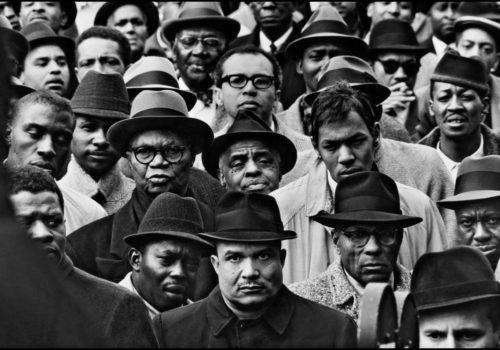Jack Shainman presents Born Black, an exhibition of Gordon Parks’s photographs—curated in collaboration with The Gordon Parks Foundation. This presentation is inspired by the 1971 book Gordon Parks: Born Black, A Personal Report on the Decade of Black Revolt 1960-1970, which brought together a collection of essays and photographs by Parks that were originally created for Life magazine. Translating the essential themes of the text into an exhibition, Jack Shainman explains, “We seek to commemorate Parks’s ground-breaking 1971 anthology, and the enduring impact of his photographs and writing today. This exhibition is an act of expansion—presenting both seminal and lesser-known works from his renowned photographic series, offering contemporary meditations on his incisive eye and insightful prose.”
Gathered in this presentation are images that were featured in, relate to, and extend beyond the photographs illustrated alongside the nine essays in Born Black. In each photo essay, it is clear that Parks’s images capture momentous scenes that exceed the limitations of language, and simultaneously, the frankness of his prose grounds the accompanying images with vital sociopolitical context and his personal perspective. Through his photography and writing—but also clear in his films, literature, and musical compositions—Parks demonstrated the value of empathy and compassion when creating art. Before picking up his camera, he took a vested interest in getting to know his subjects when embarking on a new project, taking time to situate himself both on the frontlines and front porches of the events and lives he covered. Though positioned as an outsider with his camera and pen, as a Black man in America, Parks never shied away from incorporating his nuanced impressions and political solidarity with his subjects, nor did he conceal his personal investment in the experiences, movements, and history he depicted.
Situating himself between the mainstream and the radical, this selection of works displays his efforts to portray Black Americans from youth to adulthood, a multigenerational archive that expresses the inextricable links between the urban and rural, the individual and communal, and the center and periphery. Whether anonymous or celebrated, each of his subjects prompts the viewer’s participation in critically contemplating what it means to be born into, to be shaped by, and to strive to reimagine life in the United States. His images hold both the force of who is represented and what is symbolized, like the memorialized portraits of Muhammad Ali, Stokely Carmichael, and Malcolm X shown alongside photographs of crowds gathering to protest against police brutality. In the final essay of the book, Parks reflects on his conversation with Eldridge Cleaver in which the Black Panther Party leader invited Parks to serve as their minister of information. In response, and reflection, he explained, “my interests go beyond those of the Black Panthers, to other minorities and factions of the black movement who want change…Looking back to that moment I find that I am displeased with my answer. I should have said: Both of us are caught up in the truth of the black man’s ordeal. Both of us are possessed by that truth which we define through separate experience. How we choose to act it out is the only difference. You recognize my scars and I acknowledge yours.” Parks was attuned to the importance of singular moments, everyday and monumental, in developing a comprehensive portrait of his time—a precise but inclusive vision of Black life in the twentieth-century.
This spring, Steidl, in partnership with The Gordon Parks Foundation, will release an expanded edition of Born Black that illuminates Parks’s vision for the book and offers deeper insight into the nine series within it through additional images, related manuscripts, and scholarly essays. Reflecting on the book’s enduring legacy, Peter W. Kunhardt, Jr., Executive Director of the Gordon Parks Foundation shares, “Born Black, the first book to unite Parks’s writing and photographs, illustrates his thorough effort to platform first-person narratives of Black lives and experiences across America at a time of unequivocal revolution. We are also pleased to include two new essays by renowned critics Jelani Cobb and Nicole R. Fleetwood.”
Gordon Parks (b.1912, Fort Scott, KS; d. 2006, New York, NY) was a seminal photographer and celebrated composer, author, and filmmaker. As a humanitarian with a deep commitment to social justice, his work documents many of the most important aspects of American culture with a focus on race relations, poverty, civil rights, and urban life. Born into poverty and segregation, Parks was first drawn to photography when he saw images of migrant workers published in a magazine. He purchased a camera at a pawn shop and found a job taking fashion photographs for a local clothing store in St. Paul. Parks developed his own style, allowing him to break the color line in professional photography while creating remarkably expressive images that consistently explore the social and economic impact of racism. Awarded the prestigious Julius Rosenwald Fellowship in 1942, Parks chose to work with Roy Stryker and the FSA, around which time he created American Gothic—one of his most iconic images and one of the hallmark images of the twentieth century. His 1948 photo essay on the life of a Harlem gang leader solidified his position as the first African American staff photographer for Life magazine—where he worked for two decades. His photographs captured the essence of activism and humanitarianism in mid-twentieth century America, and have become defining images of their era. They also rallied support for the burgeoning Civil Rights Movement, for which Parks himself was a tireless advocate and documentarian.
















